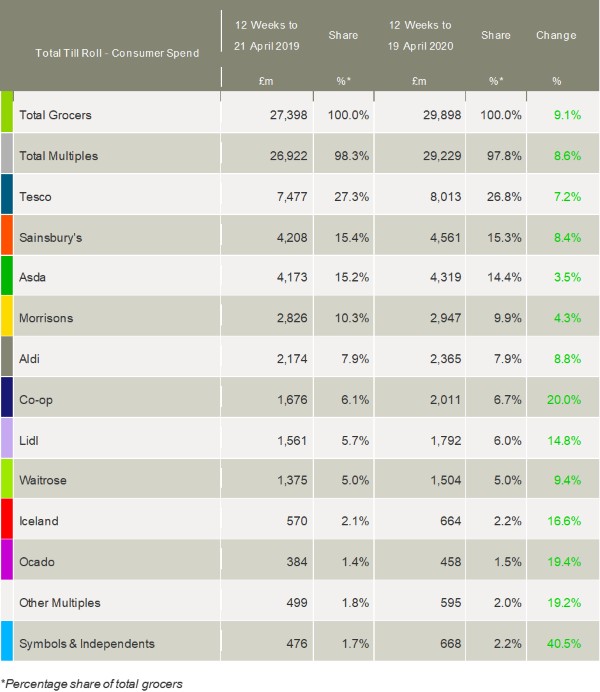Latest supermarket share data from Kantar confirms that grocery sales growth has slowed in recent weeks from record levels last month that was driven by panic buying at the start of the coronavirus outbreak. However, demand still remains high with the likes of Sainsbury’s, the Co-op, Lidl, Waitrose, and Ocado appearing to benefit the most, along with symbol and independent c-stores.
Take home grocery sales increased by 9.1% year-on-year over the 12 weeks to 19 April. However, this figure slowed to 5.5% over the past four weeks, down from the 20.6% recorded in March, as consumers settled into life under lockdown.
Nevertheless, sales this month were still £524m higher than they were in April 2019, a sizeable increase. The rise is primarily down to changing habits, as people adapt to a new way of living – for example, the number of lunches eaten at home has nearly doubled under lockdown. However, Kantar highlighted that the increased take-home sales have been partially offset by a fall in on-the-go food and drink sales, which were worth more than £350m in April last year.
Social distancing and lower footfall has also meant that expenditure in other categories like clothes and general merchandise is considerably lower, impacting grocery retailers with larger non-food offerings.
Kantar found that on average, households shopped only 14 times for groceries over the past month, a record low and down from 17 in more normal times. A drop in frequency was matched by a corresponding uplift in the amount spent on each trip to £26.02 – the highest figure ever recorded by Kantar and £7 greater than last year.
Meanwhile, with many people heeding Government advice to stay home, demand for online grocery shopping soared. Fraser McKevitt, head of retail and consumer insight at Kantar, commented: “Retailers’ efforts to increase their online capacity are clearly working, with shopper numbers up by a quarter. Online sales now account for 10.2% of overall grocery, versus 7.4% last month, with the greatest increase among older shoppers. Although not traditionally big users of e-commerce, over-65s spent 94% more on deliveries than they did a year ago.”
Large format supermarkets continue to supply the majority of Britain’s food and drink, but convenience stores, whether independently owned or run by the major grocers, are thriving as people shop closer to home. McKevitt said: “Convenience stores increased sales by 39% in the latest four weeks, now accounting for 16.3% of the market compared with 12.4% a year ago. It should be noted, however, that this rise may be offset by the downturn in on-the-go consumption, which will have had a disproportionate effect on convenience shops.”
Kantar’s data for the 12 week period shows all ten of the major grocery chains increased take home sales as shoppers firstly stocked up in preparation for lockdown, then fell into their new routines.
The Co-op’s market share rose to 6.7%, up from 6.1% last year after sales jumped 20.0%. Independent and symbol retailers, such as SPAR and Londis, also benefited from changing shopping patterns, with growth of 40.5%. Meanwhile, Ocado grew by 19.4%.
Sainsbury’s lead the way amongst the Big Four with sales 8.4% higher than this time last year. Tesco was up 7.2%, whilst Morrisons and Asda saw increases of only 4.3% and 3.5% respectively. At Iceland, sales soared 16.6% and Waitrose grew by 9.4%. Finally, the discounters continued to perform well with sales at Lidl increasing by 14.8% and Aldi up 8.8%.
According to Kantar data, grocery inflation now stands at 1.9%. Prices are rising fastest in markets such as sausages, bacon and lamb while falling in poultry, eggs and chocolate confectionery.

NAM Implications:
- Key is the extent to which these changes in shopping behaviour will become ‘permanent’ following lockdown.
- Coupled with the emergence of the cash-strapped super-savvy consumer demanding demonstrable value for money…
- Time for all stakeholders to go back to basics and reassess all aspects of their offerings?
- …as if entering a new market for the first time…




